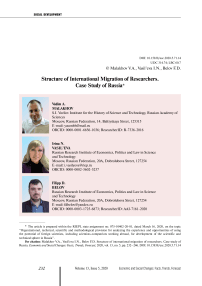Structure of international migration of researchers. Case study of Russia
Автор: Malakhov Vadim A., Vasileva Irina N., Belov Filipp D.
Журнал: Economic and Social Changes: Facts, Trends, Forecast @volnc-esc-en
Рубрика: Social development
Статья в выпуске: 5 т.13, 2020 года.
Бесплатный доступ
Gender inequality, circulation of scientific personnel, researchers, bibliometric approach, scientific career, international academic mobility, russian scientific diaspora
Короткий адрес: https://sciup.org/147225492
IDR: 147225492 | УДК: 314.74 | DOI: 10.15838/esc.2020.5.71.14
Текст статьи Structure of international migration of researchers. Case study of Russia
Problem statement and literature analysis
One of distinctive features of modern globalization era is an unprecedented level of international labor migration. High international mobility is especially typical for highly qualified specialists and scientists. Today, in many scientific disciplines, the level of involvement of a scientist in the international circulation of personnel becomes one of important signs of a successful academic career [1], and biographies of leading modern researchers contain records of work in universities and research institutes in various countries. It is not uncommon for researchers to grow up in one country, get a degree in another, and work in a third one.
Despite the fact that, while moving abroad, scientists face a number of cultural barriers that can hinder development of an academic career [2], numerous studies indicate a positive correlation between the level of mobility and scientific performance, measured by a number of articles, citations, and participation in international scientific projects [3–6]. Now, international circulation of scientific personnel is not often seen as necessarily harmful to states which scientists leave. It may promote technological transfer and development of international scientific and technical cooperation between a recipient country and a donor country of scientists [7]. Diaspora connections become an important factor for stimulating innovation and knowledge transfer. Networks of scientists-compatriots, which emerge abroad, function as some kind of a transfer mechanism that provides international knowledge exchange: this effect is particularly noticeable in high-tech industries [8]. After the collapse of the USSR, Russia faced the problem of mass intellectual emigration, and a Russianspeaking scientific diaspora was formed in Western countries, whose potential can be used for development of the domestic scientific and technical sphere [9; 10].
To better understand causes and consequences of intellectual migration, as well as to create efficient mechanisms for interaction with scientific diaspora, it is necessary to have a clear understanding of the migration structure (geographical, disciplinary, gender, age). At the same time, in Russia and abroad, official statistical sources do not provide a reliable picture of a size and directions of researchers’ migration flows [11]; therefore, the bibliometric method of assessing migration flows of scientists and identifying its structure becomes more popular among scientific researchers. By analyzing information about affiliations of authors of scientific articles, collected in bibliometric databases like Scopus or Web of Science (hereinafter – WoS), it is possible to track movements of researchers between organizations and countries [12]. In recent years, Russia has also started to use the method of bibliometric analysis to identify main migration patterns of Russian scientists [13; 14]. However, most of the works using this method only affected a certain part of Russian researchers: for example, representatives of a particular scientific branch [15] or employees of a particular university [13]. There are no works devoted to the study of the structure of international migration of all Russian scientists.
The gender and age structure of migration remains poorly studied. Due to a lack of data on authors’ age in international bibliometric systems, the age structure of migration of researchers is usually estimated by analyzing the results of questionnaire surveys [16]. The problem of women’s participation in the processes of international circulation of scientific personnel was studied to a certain extent on a case study of scientists who visited Germany with short-term visits in the 1980s and 2000s [17]. One of the important problems that interests researchers is the impact of a family and children on the work of female scientists [18; 19]. Thus, the influence of family obligations on women researchers’ international mobility is analyzed using emigration of computer scientists from former Soviet Union to the UK as an example. It is shown that, in general, academic career of female researchers, in comparison with their male colleagues, much more depends on family circumstances [20]. Another study analyzed the impact of government policies on women scientists’ willingness to work abroad [21]. Researchers note that, despite a number of problems, due to public policies implemented in many European countries, the share of women actively involved in the processes of transnational circulation of scientific personnel has been growing in recent years. The existence of social, political, family, and economic barriers affects not only international mobility of female researchers but the level of their participation in international collaborations as well [22].
Our research is a continuation of a previous work, which was devoted to the analysis of the structure (primarily gender) of migration among Russian scientists [23]. Its purpose is the analysis of the structure of international mobility of Russian researchers, its comparison with data on foreign scientists who visited
Russia due to research activities in 2018, and explanation of reasons for the formation of such structure. Information about foreign researchers, who visited Russia, was obtained through a survey of employees of Russian universities and research organizations conducted by the Ministry of Science and Higher Education of the Russian Federation in March 2019.
Research methods and initial sample
The study analyzed several complementary data sets. Information sources about the disciplinary structure and the ratio of men and women among scientists working in Russia are statistical collections of Rosstat.
The analysis of the disciplinary and gender structure of international mobility of Russian researchers was carried out using a database on those who work or have worked in foreign scientific organizations and universities. The main method, used to form the database, was bibliometric analysis. There are two ways to search for information about authors in the WoS system.
First, a sample of articles of one author was compiled for 2008–2017. The author was included in database if he had at least two affiliations during a specified period: one – with a Russian scientific organization (Research Institute or University), the other – with a foreign one. In this case, a foreign affiliation indicates that a scientist moved to another country (including temporary residence abroad). It is worth mentioning that often, even after they move abroad and start working at foreign universities, researchers continue to indicate their Russian affiliation in their articles.
Second, articles with two authors, published in collaboration with Russian scientists, were selected. As a rule, scientists who moved abroad maintain working relations with their colleagues who stayed in Russia, continuing to carry out joint publications. Co-authors who had Russian surnames (ending with -in, - ov, etc.) and affiliation with a foreign organization were considered members of the Russian scientific diaspora.
In addition, to supplement database, contact information of members of Russian scientific diaspora was collected from free sources (social networks, publications, etc.). At the final stage, database was expanded with information about fellow scientists obtained from a survey of employees of Russian universities and research institutions.
Information on each researcher was manually checked on the Internet, some repeated contacts were deleted (for example, the WoS system could count the author twice if his last name was transcribed differently in articles), a number of foreign scientists who had a Russian affiliation in 2008–2017 and accidentally got into database were identified and deleted.
Final database contains information on 2,865 Russian researchers who worked at foreign universities and research organizations. Among them, there are scientists who emigrated during the Soviet era and have virtually no contact with Russia, as well as researchers who worked abroad only temporary and currently return to their homeland. In this article, we use the terms “academic mobility”, “circulation of scientific personnel”, and “migration of researchers” interchangeably, applying them to all scientists: those who emigrated permanently or work abroad temporarily.
It should be noted that, in addition to Russian scientists themselves, the sample could include a certain number of researchers – representatives of post-Soviet countries who were affiliated with Russian universities and scientific institutions in 2008–2017, as well as scientists who left the USSR before its collapse. We refer these groups to the “scientists-comrades” category.
Disadvantages of bibliometric analysis are the limited and inaccurate information provided in databases. For example, different transliteration variants of surnames used by authors in different articles make it difficult to calculate accurately. A unique internal identification number is intended to solve this problem, but not all researchers, whose articles are indexed by WoS, have it. In addition, the sample may not include scientists who moved abroad at the beginning of their academic career and did not have a WoS publication with a Russian affiliation, as well as those who adhere to an atypical publication strategy (not publishing in journals indexed in WoS). First of all, it applies to representatives of humanities (since humanitarian journals are not as widely represented in the WoS database as natural science journals). However, in comparison with other methods of identifying scientists-compatriots (for example, search on university pages, etc.), bibliometric analysis allows covering the largest possible sample of scientists working abroad.
All researchers, selected according to this principle, were sorted by gender, scientific areas, and countries where they worked. After that, a comparative analysis of obtained groups was performed. In situations when the author’s affiliation changed in relation to institutions of different states (other than Russia), the last one was chosen for analysis. All scientific disciplines are grouped according to the broad OECD classification1. If researchers wrote articles in various scientific fields, areas where they had the largest number of publications were taken into account.
The technology for collecting information about Russian scientists, involved in international academic migration, can be mathematically represented as the sum of samples in the following areas:
SLT 1aut – articles with one author;
SLT 2aut – articles with two authors in collaboration with Russian scientists;
CompScient surv. – information about scientists-compatriots obtained from a survey of employees of Russian universities and research institutions.
Information about foreign scientists who visited Russian universities and research organizations in 2018 was obtained as a result of a survey of employees of Russian universities and research institutions conducted in March 2019. It was carried out by sending requests to 864 Russian organizations in order to collect and then analyze statistical data. Responses were received from 441 organizations: 153 universities and 288 research institutions. Information contained general data about foreign scientists; countries and organizations from where they came from; scientific direction of their activities. Responses provided data on foreign scientists who came to Russia for long-term employment and researchers who had short-term visits in Russian organizations (speeches at conferences, readings of short lecture courses and seminars, helding studies).
Figure 1. Technology and features of information collection concerning Russian and foreign scientists for comparative analysis
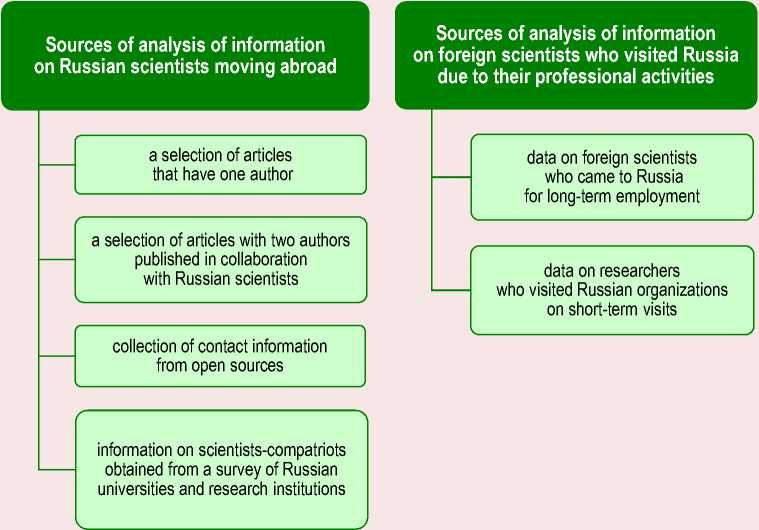
In addition to actual foreign scientists, responses contained information about members of Russian scientific diaspora who visited an organization in 2018.
All research fields, where scientists worked in, were grouped into six areas according to the broad OECD classification. In addition, all researchers were sorted by gender. If it was impossible to determine the gender according to the first and last name, information search was carried out in open sources. Data on scientists whose gender could not be determined were not analyzed. Final list of foreign scientists, who visited Russian universities and research organizations in 2018, contains 5,970 entries. It was analyzed to identify patterns of international academic mobility of foreign scientists in Russia depending on gender, country of departure, and scientific field.
In the second direction (analysis of foreign scientists who visited Russia as part of their professional activities), the method of collecting information may be presented as a sum :
SRS foriScient = ForScient long t + ForScient short t, where:
ForScient long-t – data on foreign scientists who came to Russia for long-term employment;
ForScient short-t – data on researchers who visited Russian organizations on short-term visits.
Information about foreign scientists was obtained by sending requests to Russian organizations for the purpose of collecting and analyzing statistical data.
Thus, the technology for collecting information for analysis in two directions is schematically presented in figure 1 .
At the final stage of the analysis, data on Russian and foreign scientists were combined, and both groups were sorted by several criteria. Thus, the dependence across Russian researchers will be:
SRS rus.scientsort – sorted sources of the 1st direction analysis (Russian researchers).
The sorting of Russian scientists was carried out in three directions: gender, countries, and scientific disciplines.
The sorting of foreign scientists was carried out in two directions: gender and scientific disciplines:
SRS for.scient sort = (ForScient long-t +
+ ForScientshort-t) gend,disc , where:
SRS for.scientsort – sorted sources of the 2nd direction analysis (foreign scientists).
In general, the sorting of both groups (Russian scientists affiliated with foreign scientific organizations, and foreign scientists who visited Russia in 2018) can be presented as follows:
-
1) by gender;
-
2) by countries where researchers worked;
-
3) by scientific disciplines (according to the OECD classification).
At the final stage of the study, a comparative analysis of two databases was carried out: Russian scientists who went abroad, and foreign scientists who visited Russia. This made it possible to compare the migration flows of scientific personnel sent to and from Russia within the gender and scientific areas. At the same time, the applied approach is limited by the fact that these databases were collected using different methodologies. The database on foreign researchers contains information about all scientists who visited Russian organizations in 2018 (including short-term visits), the database on Russian scientists includes information about researchers who went abroad for a long period and had a foreign affiliation.
Results of the research
As a result of bibliometric analysis and data search in open sources, 2,865 Russian scientists affiliated with foreign scientific organizations and universities were identified, only 15% of them (442 scientists) were women. At the same time, according to Rosstat data for 2016, the share of women in a number of researchers working in Russia is about 40%. These results generally confirm the conclusions of previous studies based on data from other countries about a low level of international mobility of female researchers in comparison with their male counterparts [17].
If we discuss the distribution of scientists-compatriots in scientific areas, an absolute majority of them study natural sciences (more than 70% of them). Then, engineering (about 14% of Russian scientists), social (about 6%), medical (less than 5%), humanities (about 3%), and agricultural (less than 1%) sciences are presented. The greatest gender imbalance is observed in the most numerous areas – among representatives of natural and engineering sciences. The share of women in these categories of researchers is only 13%. The situation with gender imbalance is better among representatives of medical, social, and especially humanitarian sciences ( Fig. 2 ). In nearly all industries, the share of women among migrated scientists is lower than the share of women among all those working in Russia. The exception is immigrants-representatives of humanities, among whom the share of women is approximately 40%, which corresponds to their share among all Russian researchers, but it is still inferior to the share of women among the representatives of humanities who stayed in Russia.
Figure 2. Distribution of scientists-compatriots participating in the international circulation of scientific personnel by scientific field and gender
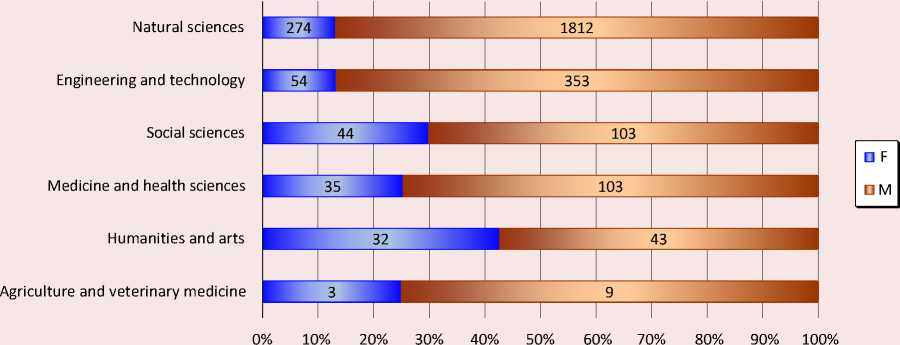
If we divide the group of Russian scientists, studying natural sciences, into narrower areas (the second level of the OECD classification), we will see that nearly half of researchers (or a third of all Russian scientists) are physicists or astronomers, many are mathematicians, followed by those who study chemical, biological sciences, as well as Earth sciences and related environmental sciences. The greatest gender imbalance occurs among mathematicians and physicists (i.e. the most widely represented scientific fields), where the share of women is only about 10%, while this number exceeds 20%, out of migrated scientists-compatriots, among biologists, chemists, and people studying Earth sciences (Fig. 3).
Figure 3. Distribution of scientists-compatriots representing natural sciences by narrow scientific areas and gender
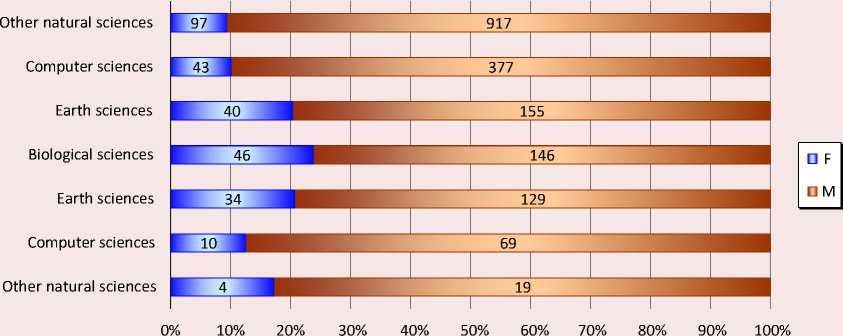
Most often, Russian scientists travel to the United States and developed countries in Western Europe ( Tab. 1 ). Among Asian countries, only Israel is among top 10 countries in terms of a number of Russian scientists working there. The first four countries on the list of recipients of scientific personnel from Russia in relation to men and women are the same: the USA, Germany, France, and the United Kingdom (although the share of women in France is slightly higher than in the United Kingdom). More than 60% of Russian scientists were affiliated with these countries’ scientific institutions. Then, there are some differences in the lists for men and women: the most noticeable one is a low proportion of women among Russian researchers who went to Israel (6 female scientists against 65 male scientists). In Sweden, Finland, and Poland, on the contrary, the share of women is higher than an average number (more than 20%). According to this data, as a result of the bibliographic analysis, Asian countries, even developed ones like Japan or South Korea, are chosen as a place of work by a relatively small number of scientific personnel: 47 scientists moved to Japan, 36 – to China, and 19 – to South Korea. This can be explained by the existence of certain cultural barriers.
At the same time, the share of women among Russian researchers working in China is very low – 2 out of 36 people, which is also related to cultural characteristics of a recipient country.
It should be noted that, in all countries where Russian scientists moved to, people who study exact sciences – primarily physics and mathematics – prevail. Among main recipient countries of Russian scientists, Finland, where the share of representatives of humanities and social sciences is high (more than 20% of Russian scientists who worked where in comparison with average 10% worldwide), stands out.
Among foreign researchers, who visited Russian universities and research organizations in 2018, 28% were women. Representatives of natural sciences formed the largest group (about 46%), followed by engineering (about 17%), social sciences (about 15%), humanities (about 14%), medical and agricultural sciences (about 4% for each group). It is interesting that, in comparison with Russian scientists who went abroad, among foreign scientists who came to Russia, the share of representatives of natural sciences is significantly lower, and the share of representatives of social sciences and humanities is significantly higher ( Fig. 4 ).
Table 1. Distribution of Russian researchers participating in the international circulation of scientific personnel by gender and countries, where they relocated to
|
Countries |
Women |
Men |
Total |
||
|
people |
share, % |
people |
share, % |
people |
|
|
USA |
88 |
13.0 |
591 |
87.0 |
679 |
|
Germany |
81 |
15.3 |
450 |
84.7 |
531 |
|
Great Britain |
37 |
14.0 |
228 |
86.0 |
265 |
|
France |
43 |
16.2 |
222 |
83.8 |
265 |
|
Finland |
15 |
20.0 |
60 |
80.0 |
75 |
|
Israel |
6 |
8.5 |
65 |
91.5 |
71 |
|
Switzerland |
11 |
15.9 |
58 |
84.1 |
69 |
|
Italy |
8 |
11.6 |
61 |
98.1 |
69 |
|
Sweden |
15 |
22.1 |
53 |
77.9 |
68 |
|
Canada |
9 |
14.5 |
53 |
85.5 |
62 |
|
Other countries |
129 |
18.1 |
582 |
81.9 |
711 |
|
Source: own compilation. |
|||||
Figure 4. Distribution of foreign scientists who visited Russian universities and research organizations in 2018 by scientific areas and gender
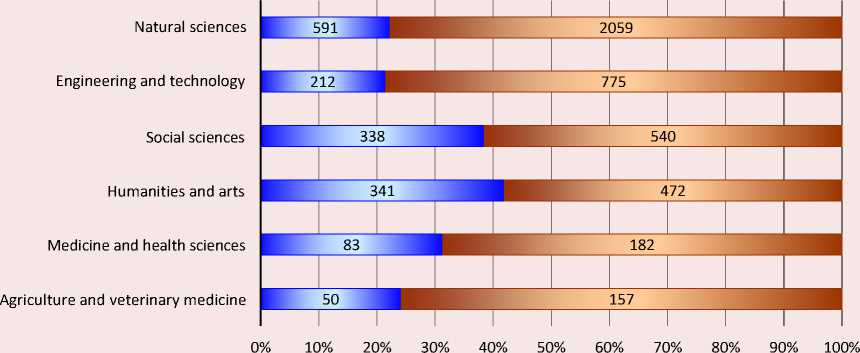
I □ F □M
It corresponds to data on Russian scientists and shows that the situation with a significant gender imbalance in STEM-disciplines (Science, Technology, Engineering, and Math) is not unique for the Russian scientific community. At the same time, the share of women among foreign scientists who visited Russia in 2018 was higher than the share of women among scientists-compatriots working abroad.
As for the distribution of foreign scientists by countries they came from, it is worth noting that Germany, China, Belarus, and the United States are leaders. The share of women is highest among scientists from neighboring countries like Ukraine (86 out of 196), Kazakhstan (179 out of 408), Bulgaria (45 out of 107), Finland (42 out of 120), and the Republic of Belarus (189 out of 504).
Interpretation of the results
Among the countries that Russian scientists choose to work in, Western Europe and North America are most common. It could be explained by their high level of socio-economic development and the existence of certain cultural and linguistic barriers to the integration of Russian researchers in Asian societies.
The disciplinary structure of migration of Russian scientists abroad is dominated by people who study natural and engineering sciences (more than 85% of authors). This distribution of scientists-compatriots by discipline could be explained by several factors:
– Russian researchers who study natural (primarily physics and mathematics) and engineering sciences are traditionally in high demand on the international labor market: this is also confirmed by other studies [13];
– a low share of representatives of medical sciences is explained by the fact that, according to the OECD classification, many of them could be attributed to representatives of natural (biological) sciences;
– a low share of representatives of humanities may be caused by relatively low representation of humanitarian journals in the WoS system and, as a result, non-inclusion of a number of Russian researchers in this area in our sample.
A significant gender imbalance among scientists-compatriots, affiliated with foreign universities and research organizations, may be caused by several factors. One possible hypothesis, explaining the inequality, is that women more than men depend on circumstances which make international mobility difficult, such as a family and children.
The research results on the impact of marriage on academic career development show that marriage often hinders successful development of women’s academic careers, while it has a simultaneous positive impact on male scientists’ careers [24]. This is due to asymmetrically distributed family obligations and existing social stereotypes. Unfortunately, analyzed databases do not contain information about the marital status of scientists for us to confirm or refute this hypothesis.
The second hypothesis that explains the greater international mobility of Russian male researchers, in comparison with women, is the presence of certain socio-cultural features in some countries. For example, a higher, compared to Russia, level of gender discrimination may not affect the decision of a male researcher, but it may limit options for abroad employment for a woman. The existence of social and cultural barriers that prevent women from finding employment in foreign scientific institutions may be seen not only in certain countries but in scientific disciplines or scientific schools established in specific organizations [17].
Let us analyze the database to test this hypothesis. It may be assumed that the lowest share of women is among fellow scientists who work in Muslim countries, which are traditionally characterized by a high level of gender inequality. We have data on five such countries: Turkey, Qatar, Kuwait, Pakistan, and Saudi Arabia. All the fellow scientists who worked there were men. Their total number was too small (14 people), and it could not significantly affect overall statistics, and the absence of women may be explained
Figure 5. Distribution of countries with the largest number of Russian-speaking scientists by the share of female scientists and Gender Inequality Index
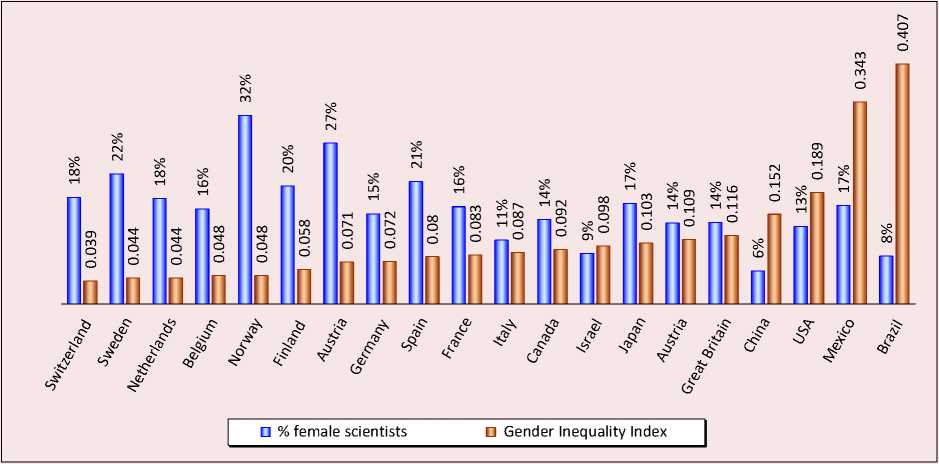
by a statistical error. In order to reduce the significance of such errors, we will analyze only the countries with more than 30 cases of researchers’ visits. If we divide the countries where Russian-speaking scientists move to according to the UN Gender Inequality Index (hereinafter – GII), it is possible to notice that the share of female scientists correlates with a value of the index. Figure 5 shows 20 countries with the largest number of Russian-speaking scientists (according to the bibliometric analysis), allocated according to GII.
It may be noted that, in 8 countries out of top ten (except Belgium and Germany), the share of female scientists is higher or equal to an average number (18%). In all countries of the second ten, the share of female scientists is below average value. There is a negative correlation between the inequality index and the share of female scientists among all members of the Russian-speaking scientific diaspora in studied countries (the higher the inequality index, the lower the share of female scientists). It suggests that Russian-speaking female scientists who leave for countries with low GII have a great chance of self-realization in science. Thus, our hypothesis (socio-cultural characteristics of countries can influence Russian female scientists’ choice of a place for immigration) was confirmed.
Finally, the third hypothesis that explains the gender imbalance in the international circulation of scientific personnel from Russia may be the fact that Russian scientists-representatives of exact sciences (physics and mathematics) are traditionally in most demand on the international labor market, and the share of women is lowest in these scientific disciplines. According to Rosstat, in 2015, only 40% of graduates of Russian universities, who were trained in physics and mathematics, were women, while 57% of graduates among all specialties were female, and the proportion of women who graduated from technical and engineering programs was even lower2. According to the bibliometric analysis, a number of women among STEM scientists who worked abroad is even lower – only 13%. Thus, this hypothesis is confirmed, and it explains a low share of women among all Russian scientists affiliated with foreign organizations, but it cannot explain why, in each individual scientific area, the share of women, involved in the international circulation of scientific personnel, is lower than among scientists working in Russia.
Analysis of the database on foreign scientists, who visited Russian universities and scientific organizations in 2018, showed that representatives of natural and engineering sciences also prevail among them, but their share in a number of foreign scientists coming to Russia is not as large as among Russian scientists going abroad. At the same time, the share of representatives of social sciences and humanities among foreign scientists is significantly higher. It could be explained by the existence of certain demand on the international market of scientific personnel and the difference in the methodology of information collection (the sample of foreign scientists includes all researchers who visited Russia, regardless of their publications in the WoS database).
Foreign scientists are also characterized by the gender distribution in scientific areas; the share of women in STEM-disciplines was significantly lower than in social and humanitarian fields. However, the share of women among foreign scientists was significantly higher than among Russian scientists in general and specific scientific areas. It is also related to peculiarities of data collection methodology: not only foreign scientists who came to Russia for employment, but also those who arrived in Russian scientific organizations and universities with short-term visits were taken into account. It could be assumed that it is easier for female scientists, even if they have a family and children, to decide on a short-term work trip abroad. At the same time, for longterm abroad employment, a family is a more significant obstacle for women than for men. To confirm this hypothesis, further research is required, since analyzed databases do not contain information about the marital status of scientists.
Conclusion
Thus, we tested the bibliometric approach for determining the structure of migration of Russian scientists. Data obtained were comparable to data on foreign scientists who visited Russia in 2018. It shows a high degree of objectivity of the bibliometric approach being a tool for determining the structure of intellectual migration. As a result of our research, we identified and interpreted the disciplinary, gender, and geographical structure of international migration of scientists with a case study Russia. It is proved that representatives of STEM-disciplines are in high demand on the international labor market (among Russian scientists, it primarily concerns physics and mathematics).
Our work clearly showed the existence of significant gender inequality in the global circulation of personnel in Russia. In comparison to men, female scientists are much less likely to choose foreign universities and research organizations as their places of work. This imbalance is typical for all academic disciplines, but it is especially noticeable in exact and engineering sciences, where the share of women is only about 13% among all Russian scientists who went to work abroad.
To explain gender inequality among Russian scientists affiliated with foreign scientific organizations and universities, we put forward three hypotheses:
-
1) Asymmetrically distributed family obligations that hinder successful development of academic careers for women scientists.
-
2) The level of gender inequality in some countries is higher than in Russia, which may be an obstacle to female scientists’ employment.
-
3) High demand on the world labor market for Russian physicists and mathematicians, among whom the share of women is traditionally low.
By analyzing database on Russian scientists, we were able to confirm the second and third hypotheses, but further research, using methods such as questionnaires and in-depth interviews, is required in order to test the first hypothesis.
While analyzing database on foreign scientists who visited Russian universities and research organizations in 2018, it was revealed that the gender and disciplinary structure of international migration of scientists among Russian researchers generally corresponds to the structure of migration of their foreign colleagues. The landscape of gender inequality across scientific areas also barely depends on the country. The share of women among foreign scientists compared to their compatriots could be explained by the difference in the methodology for collecting information, as well as by the fact that, among foreign scientists who visited Russia, there were significantly more representatives of social and humanitarian sciences, which are less characterized by gender inequality. As for the geographical structure of scientists’ migration, it is worth noting that Russian scientists mainly go to Western countries, while scientists, including neighboring countries (CIS countries, Bulgaria, China) come to Russia. Therefore, in the regional measurement, Russia remains a significant scientific center of attraction.
The results, obtained in the course of the study, may be used to develop management decisions at the government level (creation and improvement of mechanisms for interaction with fellow scientists abroad) and at the level of specific scientific organizations and universities (creation of favorable working conditions for foreign scientists, including women with families).
The study showed the prospects of the bibliometric approach application to data analysis for applied socio-political sciences and the correctness of data, obtained with its help. In the future, the approach may be refined and used in combination with other methods to assess the efficiency of public policy instruments aimed at developing international scientific and technical cooperation (for example, the “Megagrants” program, international competitions of Russian scientific foundations, etc.).
Special thanks
The authors express their gratitude to their colleague Dmitriy Stanislavovich Pokrovsky for his assistance with editing the text of the article and valuable advice.
Список литературы Structure of international migration of researchers. Case study of Russia
- Ackers L, Gill B. Moving People and Knowledge: Scientific Mobility in an Enlarging European Union. Cheltenham: Edward Elgar Publishing, 2009. 273 p.
- Antoshchuk I. The notion of diaspora knowledge network revisited: Highly skilled migrants forming a new invisible college. In: Centre for German and European Studies (CGES) Working Paper WP 2018-10, 2018. Available at: https://zdes.spbu.ru/images/WP_Antoshchuk_10.pdf
- Fernández-Zubieta A., Geuna A., Lawson C. Mobility and productivity of research scientists. In: Global Mobility of Research Scientists: The Economics of Who Goes Where and Why. London: Academic Press, 2015. Pp. 105–131.
- Petersen A.M. Multiscale impact of researcher mobility. Journal of the Royal Society Interface, 2018, 15: 20180580. DOI: https://doi.org/10.1098/rsif.2018.0580. Available at: http://rsif.royalsocietypublishing.org/content/15/146/20180580
- Jonkers K., Tijssen R. Chinese researchers returning home: Impacts of international mobility on research collaboration and scientific productivity. Scientometrics, 2008, no. 77, pp. 309–333. DOI: https://doi.org/10.1007/s11192-007-1971-x
- Franzoni C., Scellato G., Stephan P. The mover’s advantage: The superior performance of migrant scientists. Economics Letters, 2014, vol. 122, no. 1, pp. 89–93. DOI: https://doi.org/10.1016/j.econlet.2013.10.040
- Jöns H. ‘Brain circulation’ and transnational knowledge networks: studying long-term effects of academic mobility to Germany, 1954–2000. Global Networks, 2009, vol. 9, no. 3, pp. 315–338. DOI: https://doi.org/10.1111/j.1471-0374.2009.00256.x
- Kerr W.R. Ethnic scientific communities and international technology diffusion. The Review of Economics and Statistics, 2008, vol. 90, no. 3, pp. 518–537. DOI: https://doi.org/10.1162/rest.90.3.518
- Dezhina I.G., Kuznetsov E.N., Korobkov A.V., Vasil’ev N.V. Razvitie sotrudnichestva s russkoyazychnoi nauchnoi diasporoi: opyt, problemy, perspektivy [Development of Cooperation with the Russian-Speaking Scientific Diaspora: Experience, Problems, Prospects]. 2015, no. 23. Moscow: Spetskniga, 2015. 104 p.
- Dushina S.A., Lomovitskaya V.M. Distinctive features of academic mobility in today’s Russia. Sociologia Nauki I Tehnologij=Sociology of Science and Technology, 2013, vol. 4, no. 1, pp. 70–80.
- Yurevich M.A., Malakhov V.A., Aushkap D.S. Diversity of estimations of scientific migration in Russia. Nauka. Innovatsii. Obrazovanie=Science. Innovations. Education, 2017, no. 4, pp. 116–124 (in Russian).
- Moed H.F., Halevi G.A. Bibliometric approach to tracking international scientific migration. Scientometrics, 2014, vol. 101, no. 3, pp. 1987–2001. DOI: https://doi.org/10.1007/s11192-014-1307-6
- Koksharov V. A., Agarkov G.A. International scientific migration: Progress or a threat to Russia’s scientific and technological security. Ekonomika regiona=Economy of Region, 2018, vol. 14, no. 1, pp. 243–252. DOI: 10.17059/2018–1–19 (in Russian).
- Markova Y.V., Shmatko N.A., Katchanov Y.L. Synchronous international scientific mobility in the space of affiliations: Evidence from Russia. SpringerPlus. 2016, no. 5: 480. DOI: 10.1186/s40064-016-2127-3. Available at: https://springerplus.springeropen.com/articles/10.1186/s40064-016-2127-3
- Yurevich M.A., Aushkap D.S. Brain drain in computer and information sciences: a Bibliometric estimate. Informatsionnoe obshchestvo=Information Society, 2018, no. 6, pp. 46–53 (in Russian).
- Shiryaev A., Aushkap D. Digital technology research of the number of scientific diaspora. In: 2nd International Scientific conference on New Industrialization: Global, national, regional dimension (SICNI 2018). Atlantis Press, 2019. Pp. 451–454. DOI: https://doi.org/10.2991/sicni-18.2019.91
- Jöns H. Transnational academic mobility and gender. Globalisation, Societies and Education, 2011, vol. 9, no. 2, pp. 183–209. DOI: 10.1080/14767724.2011.577199
- Ward K., Wolf-Wendel L. Academic motherhood: Managing complex roles in research universities. The Review of Higher Education, 2004, vol. 27, no. 2, pp. 233–257.
- Leemann R.J. Gender inequalities in transnational academic mobility and the ideal type of academic entrepreneur. Discourse: Studies in the Cultural Politics of Education, 2010, vol. 31, no. 5, pp. 605–625. DOI: https://doi.org/10.1080/01596306.2010.516942
- Antoshchuk I. Female computer scientists from Post-Soviet space: migration and academic career in the UK. In: 23rd International Conference on Science and Technology Indicators (STI 2018). Centre for Science and Technology Studies (CWTS), 2018. Pp. 414–419. Available at: https://openaccess.leidenuniv.nl/ handle/1887/65354
- Zippel K. How gender neutral are state policies on science and international mobility of academics? Sociologica, 2011, no. 5, no. 1, pp. 1–17. DOI: 10.2383/34631
- Fox M.F., Realff M.L., Rueda D.R., Morn J. International research collaboration among women engineers: frequency and perceived barriers, by regions. The Journal of Technology Transfer, 2017, vol. 42, no. 6, pp. 1292–1306. DOI: https://doi.org/10.1007/s10961-016-9512-5
- Malakhov V.A. Gender aspect of international academic mobility of Russian scientists. Zhenshchina v rossiiskom obshchestve=Woman in Russian Society, 2019, no. 4, pp. 88–89 (in Russian).
- Ginther D.K., Kahn S. Does science promote women? Evidence from academia 1973-2001. In: Science and Engineering Careers in the United States: An Analysis of Markets and Employment. Chicago: University of Chicago Press, 2009. Pp. 163–194. Available at: https://www.nber.org/chapters/c11621

